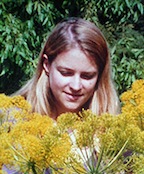Amber Priestley アンバー・プリーストリー
録音のサンプルを聞くにはタイトルをクリックして下さい /
please click on the titles to hear the music samples
CF1 : she had lost her fourteen pairs of yellow shoes (2010) for flute solo

シェラネバダ山脈の麓に生まれ、1991年より英国に住む。サセックス大学卒業後、ビル・ブロックスとロジャー・マーシュの指導のもと作曲の博士号を取得する。最近の作品としては、Then You Are in Clover (ケンブリッジ委嘱:ケンブリッジ・クィーンズカレッジ初演)、Such Nights I Get All The Free Margins (SPNM委嘱:ダミエン・ハロン初演)、Unloose to the Murmur (Exaudi委嘱・初演)、If you really loved me, you'd stop playing that piano and listen to me (クラウディア・モリトール初演)が挙げられる。
作品の多くは、音楽を演奏することと、音楽を演じること、双方を演奏家に要求する。この傾向は、わずかに曲に反映されていたり(例えばページめくりが振り付けられた作品) 、(演奏家の様々な動作が音楽を支配し、楽譜の存在を上回る作品のように)曲の大部分を占めたり、その時々である。
アンバーにとって、自由な形式の記譜法も、大きな関心のひとつである。影響を受けた一説に、『目で見えているものが全てではない、、、カメラは一瞬を独立した時として切り取り永遠に記録することが出来るものの、我々の目による記録は常に移ろいやすい』という、米国の写真家エドワード・ウェストンの記述 (1932) がある。同様に、曲の長さが一瞬ではないものの、音楽もその時々をかたち作る芸術のひとつと考えられる。時について、演奏時間を予め定めず、その時々を演奏家に委ねることで、一つの楽譜でさまざまな演奏体験を産み出す可能性から、記譜法の自由に興味を持っている。また、伝統的なジャズ即興のような規則を超え、演奏家個人の姿を反映させるという点からも、自由な記譜は彼女の作曲に欠かせない。
完成された楽譜のヴィジュアル面にこだわりを持ち、特に素朴ながらもエレガントな五線譜 (ストライプ模様) がお気に入りである。美的センスを刺激され、音楽のストライプを楽譜にデザインし、作曲に喜びを見いだしている。
Born in the shadow of the Sierra Nevada Mountains, Amber Priestley has lived in the U.K. since 1991. She obtained her Bachelor of Arts at the University of Sussex, and has her doctorate in composition at the University of York with Bill Brooks and Roger Marsh. Some recent performances include: Then You Are In Clover (students/staff of Queens' College, Cambridge; Queens' College, Cambridge commission); Such Nights I Get All The Free Margins (Damien Harron; spnm commission); Unloose to the Murmur (Exaudi commission); and If you really loved me, you'd stop playing that piano and listen to me (premiere by Claudia Molitor, 6/7/10) .
The majority of her work deals directly with musicians performing both music and theatre. Some of this forms a very small portion of the performance (for example, choreographed page turns) or a fundamental portion of the performance (such as where the music is the least important element, with the focus on the various movements of the musicians).
Another of her major preoccupations lies in open-form scores. In 1932, the American photographer Edward Weston wrote that photography "is not all seeing in the sense that the eye sees…Our vision is in a constant state of flux, while the camera captures and fixes forever a single, isolated, condition of the moment." As in photography, most concert music is also an attempt to define a certain time (in music it is the length of the piece of music). This certain length of time will be very similar each time it is experienced in most music. Amber is interested in trying to allow again for a possibility where time is not fixed, and each time a piece is experienced, the music has the chance to be different. The other separate reason that Amber is interested in open-form scores is that she would like, without use of traditional jazz-style improvisation, to allow for the performer's own individuality to emerge through her scores.
Amber is particularly fascinated by the visual aspect of a completed score, especially simple but elegant staves which are, in fact, stripes! She finds these stripes to be æsthetically pleasing and add to the joy of composition.
In the years following her PhD, Amber's music has been funded largely through her work as a civil servant with DEFRA and by weekly payments from the DSS.